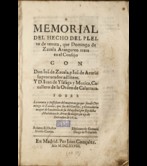Mayorazgo
Mayorazgo (majorat) was one of the basic legal concepts in Gipuzkoa’s social and economic history from the early 16th century (introduced in 1505 through the Castilian edict known as the “Leyes de Toro”) until the laws of disassociation of 1820-1841. Mayorazgo and Vínculo (association) are terms that are similar but not synonymous: the former requires a royal warrant before it can come into force, the second is a mere trusteeship that is fully legally binding but subsidiary in nature. While the former was more widespread among the ruling classes and the latter was universally used throughout Guipuzcoan society, both mechanisms removed productive assets from the market. As a result of this, in the 18th century, arbitristas (projectors) and economists began advocating that they should be abolished.
The concept of the mayorazgo (maiorazkoa, premua) meant that a family could keep all its goods and assets, without having to divide or separate them, for generations. In this way, goods and property functioned as an indivisible whole that was associated with a noble lineage. Thus, mayorazgo fulfilled a basic economic function, as it prevented the division and share-out of a productive whole that was deemed to be profitable, and allowed it to continue in the same way. The last full owner of the goods and property was the person who established the mayorazgo, and his successors and heirs could only enjoy a full ownership that was purely theoretical, given that they did not enjoy free access to said assets; they were, therefore, more usufructuaries than owners. Paradoxically, the fact that it was impossible to divide up his assets often forced the mayorazgo to go into debt in order to pay the rest of the heirs their due share, and so in practice, the opposite of the desired effect was often achieved.
In fact, just like an economic concept (and even more so, in fact), mayorazgo can be considered as a means of social reproduction. When all is said and done, mayorazgo was everlasting, while its administrators were temporary. It was not an egalitarian concept – on the contrary, it was perfectly hierarchical and regulated, always with the ultimate objective of maintaining and improving a family within a noble lineage. The mayorazgo had to demonstrate, through his work and efforts, that he really was a worthy governor of the house, and he had to fulfil responsibly his obligations to the other family members. These, in turn, had to demonstrate their worth in the sphere allotted to them, whether it was compensation for marrying out of the home, a military or other type of career, religion, emigration or a marriage of convenience. In the rules for the succession of the mayorazgo, the founder could choose to decide the system of succession, which might be one of rigorous agnation, or which showed preference to men over women, etc., or by specifying the names of his successors. Therefore, the continuity of the mayorazgo was elective, and could be left in the hands of the heir or heiress whom the donor considered to be deserving of this responsibility. The heir or heiress then came to embody the mayorazgo, and in fact the person became considered and described as the mayorazgo.
This legal concept continued in force until the law of disassociation of 1820, which abolished all such associations. Even so, it persisted for some time in certain areas by means of a legal ruse, given that the law did not cover donations between living persons; thus, the possessor of the mayorazgo could give it to his son as a contribution to his marriage; the son then became the new lord of the house, and his parents could enjoy the use of half of the noble abode.




